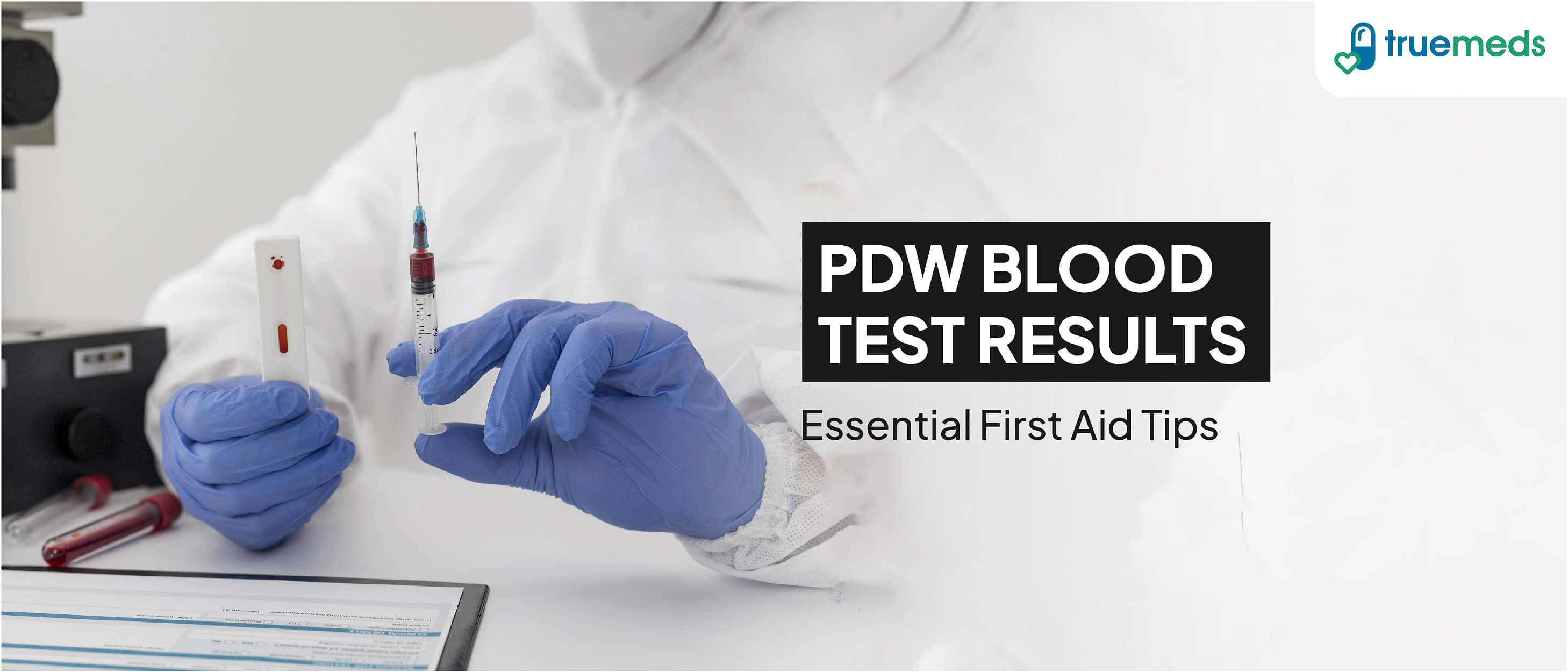Platelet Distribution Width (PDW) Blood Test: Interpretation, Management, and Related Disorders
Last updated on : 26 Dec, 2024
Read time : 8 min
Understanding our health is crucial and can be complex. However, one way in which doctors can help us understand our health better is through various blood tests. One such test is the Platelet Distribution Width (PDW) Blood Test. This test provides significant insights into how our body is functioning, especially concerning conditions involving platelets in our blood.
Key Highlights
- PDW is a measure of the variability in platelet size, which gives information about platelet activation and function.
- High PDW can be a possible indicator of health conditions like tumours, blood disorders, iron deficiency, and cardiovascular or respiratory diseases.
- The key to managing high PDW is tackling the root cause – this could involve treating the primary disease, addressing iron deficiency or initiating antiplatelet therapy.
- Regular monitoring of your PDW along with other platelet indices can provide crucial insights into your health condition.
Platelet Distribution Width Overview
The PDW test is an essential yet straightforward tool in a doctor’s arsenal. Let’s delve deeper to understand what PDW is and how it impacts our health.
What is PDW?
Platelets are tiny blood cells produced by large cells called megakaryocytes in your bone marrow. They play a vital role in forming clots to stop bleeding. PDW is a measure of how much the size of platelets in your blood varies.
Typically, the normal range for PDW is between 15.1% and 17.9% when measured by automated haematology analysers. However, factors such as diseases involving platelet activation, iron deficiency anaemia, and even age, sex, and genetic factors can influence your PDW levels.
A higher PDW suggests greater variability in platelet size, which could occur because of increased platelet activation or the presence of larger, more reactive platelets in circulation. Active platelets are involved in clot formation, which is a response to injury but can also be a sign of underlying conditions like inflammation or disease.
Thus, understanding your PDW levels plays a crucial role in proactive healthcare management and enables you to take appropriate steps toward wellness. Regular check-ups with your family doctor are essential for maintaining good health.
| Did you know! PDW is not only useful for diagnosing medical conditions, but it also plays a crucial role in forensic science. Forensic pathologists can use PDW measurements to help determine the cause of death in certain cases, such as differentiating between sudden cardiac death and other causes. This adds an intriguing layer to how medical science can intersect with legal investigations. |
How is the PDW Blood Test Performed?
The PDW blood test is a crucial component of routine medical check-ups. This test helps measure the variability in the size of platelets present in our blood. In other words, it gives us an insight into the range of sizes that platelets come in. The PDW blood test is usually performed as part of a larger evaluation and is often included in a Complete Blood Count (CBC) or a platelet function assessment.
Here’s a simple step-by-step explanation of how the PDW blood test is done:
- A trained healthcare professional collects a blood sample, typically from a vein in your arm using a small needle. The process involves minimal discomfort and lasts just a few minutes.
- Once the sample is collected, it is carefully stored in a tube.
- The tube is then sent to a laboratory, where it is analysed using an automated haematology analyser.
- This machine calculates the PDW value by examining the size variation of platelets in the blood sample.
- After the analysis, your doctor will receive the results and discuss them with you.
Normal PDW Range and Interpretation
The standard reference interval for PDW typically falls between 9.0% and 17.0% for adults. A PDW value below 9% signifies more uniform platelet size, which usually suggests normal platelet function. However, a PDW value above 17% indicates a greater variability in platelet size, which can be a sign of increased platelet activation.
It’s important to note that elevated PDW values have been associated with several health concerns. Therefore, regular monitoring of PDW along with other platelet indices is important.
Understanding High PDW
As stated above, a high PDW, particularly values above 16.7%, can be an indication of several health concerns. Here’s what an elevated PDW may suggest:
- Greater variability in platelet size, suggesting increased platelet activation.
- More severe clinical profiles, that is, more severe symptoms and worse outcomes, and higher mortality rates in patients with conditions like cardiovascular disease, diabetes, or chronic inflammatory diseases.
- Increased risk of abnormal blood clotting (also known as thrombosis) and complications due to bleeding.
- Early signs of preterm birth in pregnant women.
- Progression and prognosis of long-term diseases like cancer, bleeding disorders, and thyroid disorders.
Managing High Platelet Distribution Width
Now that we understand what high PDW might indicate, let’s look at how one might manage it.
The key to managing high PDW is identifying and addressing the underlying cause. Here are some strategies that doctors might recommend:
- Undergoing treatment for the primary disease causing platelet activation, such as cancer, cardiovascular disease, or respiratory disorders.
- Managing iron deficiency anaemia through diet or supplements.
- Considering antiplatelet therapy if high PDW is because of abnormal platelet function.
- Regular monitoring of PDW along with other platelet indices to track disease progression and treatment response.
While these steps can help manage high PDW, remember that they should be guided by your doctor’s advice.
Platelet-Related Blood Disorders
Platelet disorders often involve a decrease in the number of platelets, a condition commonly termed thrombocytopenia, or a problem with the function of the platelets. These functional disorders may be inherited (although this is rare) or acquired (which is more common).
The major platelet-related blood disorders include:
- Immune Thrombocytopenia (ITP): This is an autoimmune disorder in which the body mistakenly attacks its own platelets, leading to a low platelet count.
- Thrombotic Thrombocytopenic Purpura (TTP): A rare disorder characterised by low platelet counts and clots that develop in small blood vessels.
- Von Willebrand Disease: This is the most common inherited bleeding disorder and is caused by a deficiency or abnormality of von Willebrand factor, which is required for proper platelet adhesion.
- Glanzmann Thrombasthenia: This is another rare inherited disorder where the platelets fail to aggregate properly because of dysfunction.
Diagnosis and Management of Platelet Disorders
Diagnosing platelet disorders involves various tests including blood tests, genetic tests, and, in certain cases, even bone marrow examination. The key tests typically include the following:
- CBC, used to check the number of platelets.
- Platelet function tests, which assess the effectiveness of your platelets.
- Genetic testing, which is used primarily for diagnosing inherited disorders
The treatment plan varies depending on the specific disorder and its severity. Some common treatment options include:
- Medications to boost platelet production or prevent their destruction
- Platelet transfusions, especially in cases of severe bleeding
- Addressing the underlying cause, such as autoimmune disorders
- Avoidance of certain medications that affect platelets, like aspirin
Complications of Platelet Disorders
Platelet disorders can lead to various complications, such as:
- Severe or prolonged bleeding, particularly after injuries or surgical procedures
- Depleted iron levels due to chronic bleeding
- Potential damage to organs from blood clots in disorders like TTP
Conclusion
To sum up, the PDW blood test is an important health check up. It shows how varied your platelets are in size, which can hint at different health issues. A high PDW level might signal serious problems like tumors, blood disorders, or heart diseases. Managing these health issues, such as treating the main disease or addressing iron deficiency, is key to controlling high PDW levels. Regular PDW checks, along with other platelet tests, help doctors understand your health better and assessing PDW helps doctors give effective and personalised care to each patient.
Frequently Asked Questions (FAQs)
A high PDW indicates a larger variation in platelet size, which could suggest health conditions like inflammation, anaemia, heart disease, or cancer. Follow up with your doctor if your PDW is high.
A low PDW means your platelets are uniform in size. While this can be normal, it may hint at conditions like aplastic anaemia or chemotherapy side effects if other blood results are abnormal. Consult your doctor for a diagnosis.
A normal PDW, typically between 15.0 and 17.0 femtoliters (fl), means platelet size variation is within an acceptable range, usually indicating no serious platelet-related health issues.
There’s no direct evidence linking vitamin D deficiency to high PDW. However, maintaining healthy vitamin D levels is important for overall health.
Treating high PDW involves addressing the underlying cause. This may include medications for inflammation or lifestyle changes. Always follow your doctor’s advice for managing your health.
Disclaimer
Our healthcare experts have carefully reviewed and compiled the information presented here to ensure accuracy and trustworthiness. It is important to note that this information serves as a general overview of the topic and is for informational purposes only. It is not intended to diagnose, prevent, or cure any health problem. This page does not establish a doctor-patient relationship, nor does it replace the advice or consultation of a registered medical practitioner. We recommend seeking guidance from your registered medical practitioner for any questions or concerns regarding your medical condition.
Popular Articles
Recommended Articles
Recent Articles
Top-Selling Medicines:
...View more
Top-Selling OTC:
...View more
Company
About UsHealth ArticleHealth StoriesDiseases & Health ConditionsAll MedicinesAll BrandsNeed HelpFAQSubscribe
Registered Office Address
Grievance Officer
Download Truemeds

Contact Us
Our customer representative team is available 7 days a week from 9 am - 9 pm.
v3.7.11
Our Payment Partners



























































